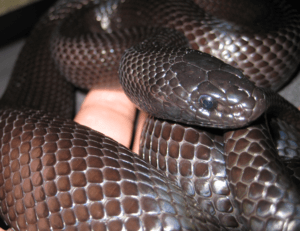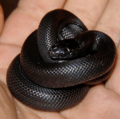Mexican black kingsnake facts for kids
Quick facts for kids Mexican black kingsnake |
|
|---|---|
 |
|
| Scientific classification |
|
| Kingdom: | Animalia |
| Phylum: | Chordata |
| Class: | Reptilia |
| Order: | Squamata |
| Suborder: | Serpentes |
| Family: | Colubridae |
| Genus: | Lampropeltis |
| Species: | |
| Subspecies: |
L. g. nigrita
|
| Trinomial name | |
| Lampropeltis getula nigrita Zweifel and Norris, 1955
|
|
The Mexican black kingsnake (Lampropeltis getula nigrita) is a cool type of snake. It belongs to a big group of snakes called the colubrid family. This snake is a subspecies of the common kingsnake.
You can find these snakes in rocky areas and places with lots of plants. They live in parts of the Sonoran Desert, Northwestern Sinaloa, Mexico, and some small areas of Arizona. Many people also keep them as pets. They are known for being easy to care for.
Contents
About the Mexican Black Kingsnake
What Does This Snake Look Like?
The Mexican black kingsnake is usually a deep, dark chocolate color. It's not truly black, but it can look that way! If you see one in bright light, you can often notice its rich, dark brown color.
Young snakes might have small white or yellow spots. These spots are often found under their chin. But as they grow up, these markings usually fade away or disappear completely. An adult snake typically has no rings or other markings.
Shiny Scales and Their Meaning
The scales of this snake have a special "blueish" shimmer. This shine is very noticeable on their belly scales. It looks a bit like the inside of an oyster shell! This shiny look is why they are called Lampropeltis. This name means "shiny shield" in Greek. It describes how their scales look.
How Do These Snakes Behave?
Mexican black kingsnakes are constrictors. This means they wrap their strong bodies around their prey. They squeeze their prey until it can't breathe. They do not have venom, so they rely on their strength to hunt.
They are active both during the day and at night. However, they usually hunt during the daytime. They use their eyesight to find their next meal. Even though their vision isn't super sharp, they are very good at spotting movement.
Where They Live and Hunt
These snakes like rocky places and areas with thick plants. They are often found in the Sonoran Desert and parts of Mexico and Arizona. They are good at finding food. They often visit burrows of small animals to look for their next meal.
While they mostly stay on the ground, they can climb low plants. They are also surprisingly good swimmers!
What Do They Eat?
The Mexican black kingsnake eats many different things. Their diet mainly includes small rodents like mice, lizards, birds, and eggs. They also eat other snakes! This is called ophiophagy. They are especially known for eating rattlesnakes. Because of this, they have developed a way to resist different kinds of snake venom.
Some snakes found in Arizona are a mix of different kingsnakes. They might be part Mexican black kingsnake, California kingsnake, or desert kingsnake. This happens because different types of kingsnakes often breed together in these areas.
Caring for a Mexican Black Kingsnake as a Pet
Mexican black kingsnakes are popular pets. They are quite easy to care for and usually have a good nature. They are also not picky eaters, which makes feeding them simple.
Temperament of Pet Snakes
These snakes like to be alone most of the time. But they still need to be active and move around to stay healthy. If a kingsnake feels scared or bothered, it might rattle its tail. It will beat its tail against the ground. This is a warning sign, much like what a rattlesnake does.
This behavior is common among many colubrid snakes, like corn snakes. It means they want to be left alone. While it's rare, some might try to bite if they are still bothered.
Why Keep Them Alone?
In the wild, Mexican black kingsnakes eat other snakes. This includes rattlesnakes. Because of this, it's best to keep them in their own enclosure. They should not be housed with other snakes.
What to Feed Your Pet Snake
In captivity, these snakes stay healthy with a diet of rodents. This includes mice and rats. They are not picky eaters. Many owners prefer to feed their snakes rodents that have already been killed. This is safer for the snake. Live mice or rats can bite and scratch the snake while trying to defend themselves.
Some owners feed their snakes in a separate container. This can help reduce any aggressive behavior during feeding time. You can usually find frozen mice at pet stores that sell reptiles. Snakes digest almost all of their food. So, they don't need extra vitamins or minerals.
Heat, Light, and Bedding for Your Snake
Mexican black kingsnakes need a warm home. During the day, their enclosure should be between 26 and 29 degrees Celsius. At night, it should be a bit cooler, between 21 and 24 degrees Celsius. You can use a heat lamp and a heater under the tank to create this temperature difference.
Always check any heated surface before your snake touches it. Heating rocks are not recommended. Snakes might stay on them too long and get burned. A thermometer and a hygrometer (to measure humidity) are very helpful tools.
Humidity and Cleaning
The humidity in their enclosure should be between 40 and 60 percent. If the humidity is too low, it can cause breathing problems for the snake. Always provide fresh water every day. It's important to clean up any waste right away. This helps prevent infections.
Choosing the Right Bedding
Aspen is a popular choice for bedding (called substrate) for these snakes. Pine and cedar are not safe because they can be toxic. Other options like sand or certain types of dirt can also be used.
It's important to make sure any bedding or decorations are safe for your pet. They should not be toxic or carry bacteria. The snake's home should be cleaned every month. The bedding should be completely replaced at this time.
Lighting Needs
It's not clear if these snakes need special UVB light. However, they do need a regular cycle of daytime and nighttime light. Not having enough light can stress them out. It can also lead to health problems.
Size, Weight, and How Long They Live
In the wild, most kingsnakes are about 90 to 120 centimeters long (3 to 4 feet). They are usually plump and strong. But in captivity, some kingsnakes can grow even bigger, up to 1.5 meters (5 feet) or more! This is probably because they get more food and a more stable diet as pets.
Adult Mexican black kingsnakes can weigh up to 1.3 kilograms (3 pounds). They can live for a long time, usually between 20 and 30 years.
Common Health Issues
Like many animals, kingsnakes can get sick or have parasites. Some common problems include:
- Scale rot: This is a skin infection.
- Mouth rot: An infection in their mouth.
- Pneumonia: A breathing infection.
- Snake mites: Tiny bugs that can live on snakes.
Many of these issues happen if the snake's home isn't clean. Or if the heat, light, or humidity levels are wrong. You can help prevent these problems by keeping their enclosure clean. Make sure they have the right temperature, light, and clean water.
Images for kids



